To design 4x4 Mesh, Fat Tree16, Ring16 and Double Ring networks using CONNECT based NoC that embodies a set of FPGA-motivated design principles that uniquely influence key NoC design decisions, such as topology, flit width, router pipeline depth and flow control. The flexibility, lightweight nature and high performance of CONNECT-based NoCs makes them ideal candidates for use in FPGA-based research studies. In this project evaluating these networks with different FPGA family and analysing the efficient FPGA family using the Xilinx ISE software. In the 4x4 mesh configuration when evaluated using synthesis results of different FPGA family, reduced logic resource cost is obtained. To demonstrate CONNECT's flexibility and extensive design space coverage, different CONNECT networks are synthesized
Keywords |
| CONNECT, NoC, FPGA, Xilinx |
INTRODUCTION |
| Network-on-Chip (NoC) is an emerging paradigm for communications within large VLSI systems implemented on a
single silicon chip that is called the layered-stack approach to the design of the on-chip intercore communications the
Network-on-Chip (NOC) methodology. In a NoC system, modules such as processor cores, memories and specialized
IP blocks exchange data using a network as a public transportation sub-system for the information traffic. A decisions at
the switches. A NoC is similar to a modern telecommunications network,using digital bit-packets switching over
multiplexed links. Although packet-switching is sometimes claimed as necessity for a NoC, there are several NoC
proposals utilizing circuit-switching techniques.This definition based on routers is usually interpreted so that a single
shared bus, a single crossbar switch or a point-to-point network are not NoCs but practically all other topologies are
somewhat confusing since all above mentioned are networks (they enable communication between two or more devices)
but they are not considered as network-on-chips. This paper is organised as follows : Section II describes introduction
to NoC terminologies. Section III describes CONNECT router architecture. Section IV describes about flit data width
analysis. Section V describes about conclusion and future work. |
NoC TERMINOLOGIES |
| A. Packets |
| Packets are the basic logical unit of transmission at the endpoints of a networks. |
| B. Flits |
| When traversing a network, packets, especially large ones, are broken into its (flow control digits), which are the
basic unit of resource allocation and flow control within the network. Some NoCs require special additional header or
tail its to carry control information and to mark the beginning and end of a packet [10]. |
| C. Virtual Channels |
| A channel corresponds to a path between two points in a network. NoCs often employ a technique called virtual
channels (VCs) to provide the abstrac-tion of multiple logical channels over a physical underlying channel. Routers
implement VCs by having non-interfeRing it buffers for different VCs and time-multiplexed shaRing of the switches
and links. Thus, the number of implemented VCs has a large impact on the buffer requirements of an NoC. Employing
VCs can help in the implementation of protocols that require traffic isolation between different message classes (e.g. to
prevent deadlock). |
| D. Flow Control |
| In lossless networks a router can only send a it to a downstream receiving router if it is known that the downstream
router's buffer has space to receive the it. Flow control refers to the protocol for managing and negotiating the available
buffer space between routers. Due to physical separation and the speed of router operation, it is not always possible for
the sending router to have immediate, up-to-date knowledge of the buffer status at the receiving router. In credit-based
flow-control, the sending router tracks credits from its downstream receiving routers. At any moment, the number of accumulated credits indicates the guaranteed available buffer space (equal to or less than what is actually available due
to delay in receiving credits) at the downstream router's buffer. Flow control is typically performed on a per-VC basis. |
| E. Input-Output Allocation |
| Allocation refers to the process or algorithm of matching a router's input requests with the available router outputs.
Different allocators offer different trade-offs in terms of hardware cost, speed and matching efficiency. [10] Separable
allocators form a class of allocators that are popular in NoCs. They perform matching in two independent steps, which
sacrifices matching efficiency for speed and low hardware cost. |
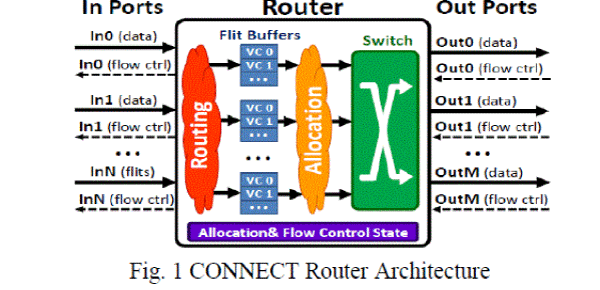 |
| Driven by the special characteristics of FPGAs, a simple router architecture to serve as the basic building block for
composing CONNECT networks. Our router design was implemented using Bluespec System Verilog (BSV).
CONNECT routers are heavily configurable and among other parameters they support -variable number of input and
output ports, variable Number of virtual channels (VCs), variable it width, variable it buffer depth, two flow control
mechanisms, flexible user-specifed routing, four allocation algorithms. |
FLIT DATA WIDTH ANALYSIS |
| A. Introduction |
| In this chapter 4x4 Mesh, Fat Tree16, Ring16 and Double Ring networks are designed with 32, 128,256-bits flit
data width using CONNECT based NoC. To evaluate the CONNECT NoC architecture and highlight its flexibility and
extensive design space coverage examine CONNECT networks on FPGA resource usage (LUTs) and frequency
estimates from synthesis report for different FPGA family like Virtex 4,Virtex 5,Virtex 6 in Xilinx ISE 14.2 version. |
| B. 4x4 Mesh Network |
| In the Figure 1 a 4x4 Mesh network is designed and it consist of 16 routers with a flit data width of 32-bits and 4
virtual channels. Flit data width determines the data transmission rate of the routers. The network is designed on partial
Mesh topology and each router is connected to some of its neighbouring routers. Router 5,6,9 and 10 is connected to
maximum to four neighbouring routers. Routing technique is used to know the path availability from source to
destination. The network is quite reliable, as there is often more than one path between source and destination in the
network. |
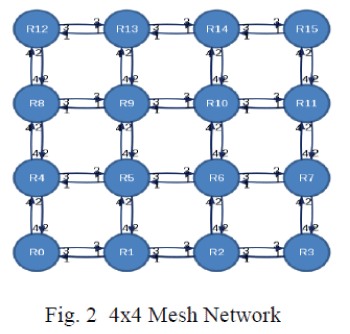 |
 |
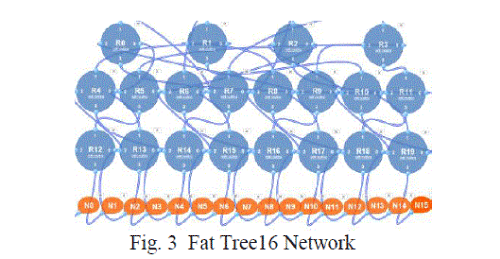 |
| In the Figure 3 a Fat Tree16 network is designed and it consist of 20 routers , 2 virtual channels specified with a
flit data width of 32,64,128-bits and this determines the data transmission rate of the routers. It consist of 16 nodes(N0
to N15) and they are resources. The main characteristic of Fat Tree is that the links that connect nodes from different
levels may have different bandwidth depending on their utilization. The complexity of nodes grows as they get close
to the roots. It is recursively scalable and easily partitionable network. |
 |
| In the comparison Table 2, synthesis results of 4x4 Mesh network is compared with 32,64,128-bit flit data width in
Virtex 6 FPGA family. LUTs utilization is increases by 1 percent and frequency increases when synthesized with higher
order bits like 64 and 128-bits. When each bits compared with different FPGA families Virtex 6 family is efficient in
LUTs usage. |
| D. Ring16 Network |
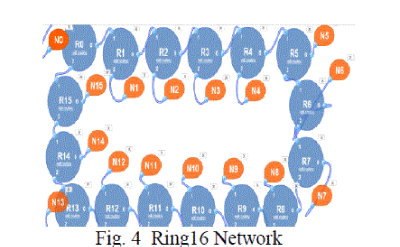 |
| In the Figure 4 a Ring16 network is designed and it consist of 16 routers, 4 virtual channels specified with a flit
data width of 32,64,128-bits.Flit data width determines the data transmission rate of the routers. Routers from R0 to
R15 are connected circularly . It consist of 16 nodes (N0 to N15). A Ring network is a standard circular topology in
which each router is connected directly exactly two other nodes, forming a circular pathway and provides only one
pathway between any two routers. |
 |
| In the synthesis results of Ring16 with 32,64 and 128-bit flit data width, Virtex 6 FPGA family is efficient.From
the comparison Table 3 the frequency variation is high but increase in LUTs usage is with very less variation when the
network is designed with higher order bits. |
| E. Double Ring Network |
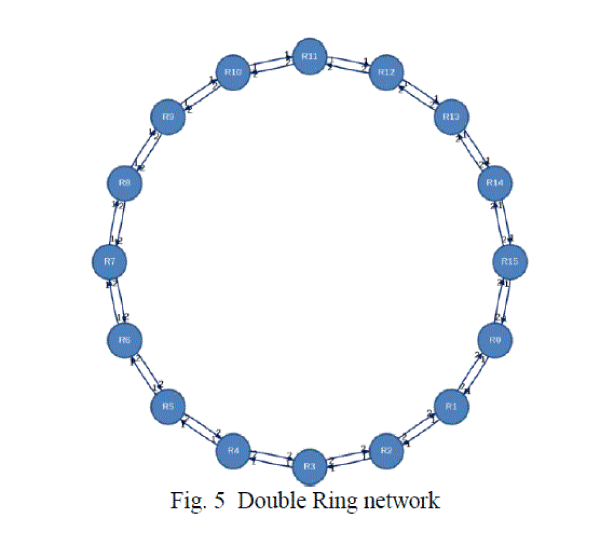 |
| In the Figure 5 a Double Ring network is designed and it consist of 16 routers, 4 virtual channels specified
with a flit data width of 32,64,128-bits. Flit data width determines the data transmission rate of the routers. It consist of
two concentric Rings that connect each node on a network instead of one network Ring that is used in a Ring topology.
Secondary Ring in a dual-Ring topology is redundant. It is used as a backup in case the primary Ring fails. In these
configurations, data moves in opposite directions around the Rings. Each Ring is independent of the other until the
primary Ring fails and the two Rings are connected to continue the flow of data traffic. |
 |
| In the comparison Table 4, synthesis results of Double Ring network is compared with 32,64,128-bit flit data
width in Virtex 6 FPGA family. LUTs utilization is increases by 1 percent and frequency deccreases when synthesized
with higher order bits like 64 and 128-bits. When each bits compared with different FPGA families Virtex 6 family is
efficient in LUTs usage. |
CONCLUSION |
| Network topologies such as 4x4 Mesh, Fat Tree16, Ring16 and Double Ring are designed using CONNECT based
NoC. These networks has been designed with different flit data width like 32,64,128 and 256. Each network is
synthesized with Xilinx ISE 14.2 software. Synthesis results has been compared with different FPGA family like
Virtex 4 , Virtex 5, Virtex 6. In the synthesis report of these networks with all types of bit values the LUTs usage has been decreased in Virtex 6 family. Synthesis report shows that Virtex 6 family is very efficient in reducing area and
FPGA cost compared to other family. In future designing different networks, performing simulation and analyzing the
latency and network performance. |
References |
- Hilton.C, B.Nelson âÃâ¬ÃÅA Flexible Circuit-Switched NoC for FPGA-based SystemsâÃâ¬ÃÂ. International conference on Field Programmable logic and applications,2005.
- G. Schelle and D. Grunwald. âÃâ¬ÃÅExploRing FPGA Network on Chip Implementations Across Various Application and Network LoadsâÃâ¬ÃÂ.In International Conference on Field Programmable Logic and Applications, 2008.
- Shelburne, M. Patterson, C. Athanas, P. Jones, M.Martin, B.Fong. âÃâ¬ÃÅMetaWire: Using FPGA Conguration Circuitry to Emulate a Network-on-ChipâÃâ¬ÃÂ.In International Conference on Field Programmable Logic and Applications, 2008.
- D. Wang, N. Jerger, and J. Stean : âÃâ¬ÃÅA programmable architecture for NoC simulation on FPGAsâÃâ¬ÃÂ. In Fifth IEEE/ACM International Symposium on Networks on Chip (NoCS), 2011.
- I. Kuon and J. Rose. âÃâ¬ÃÅMeasuring the Gap Between FPGAs and ASICsâÃâ¬ÃÂ. IEEE Transactions on Computer-Aided Design of Integrated Circuits and Systems, 2007, Vol. 26, pp 203 âÃâ¬Ãâ 215.
- M. Saldana, L. Shannon, J. S. Yue, S. Bian, J. Craig and P. Chow. âÃâ¬ÃÅRoutability of Network Topologies in FPGAsâÃâ¬ÃÂ. IEEE Transactions on Very Large Scale Integration (VLSI) Systems, 2007, Vol. 15, pp 948 âÃâ¬Ãâ 951.
- M. K. Papamichael and J. C. Hoe. âÃâ¬ÃÅCONNECT: Re-Examining Conventional Wisdom for Designing NoCs in the Context of FPGAsâÃâ¬ÃÂ. In FPGA, 2012.
- J. Lee and L. Shannon. âÃâ¬ÃÅThe Effect of Node Size, Heterogeneity, and Network Size on FPGA based NoCsâÃâ¬ÃÂ. In International Conference on Field-Programmable Technology (FPT), 2009.
- Shelburne, M. Patterson, C. Athanas, P. Jones, M.Martin, B. Fong, R. âÃâ¬ÃÅMetaWire: Using FPGA Configuration Circuitry to Emulate a Network-on-ChipâÃâ¬ÃÂ.In International Conference on Field Programmable Logic and Applications (FPL), 2008.
|